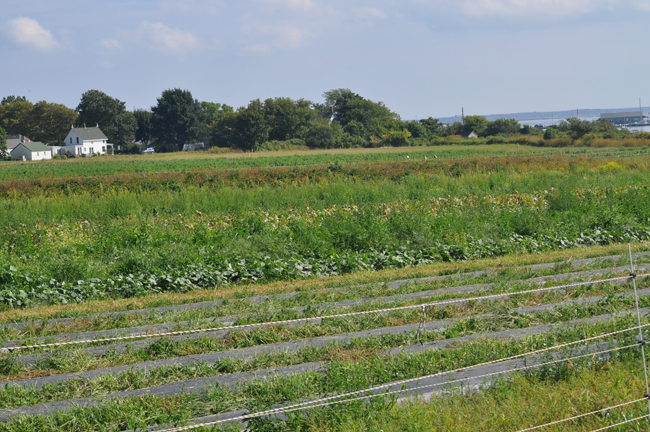Guest Spot: Safeguarding our scenery’s crown jewel

“When I cross that causeway, my whole mood changes.”
My friend was referring to the emotional lift she gets every time she enters Orient from the west. No wonder. What greets her eyes is a sublime view of fertile farmland sloping down to wetlands and, beyond them, the ever-alluring waters of Orient Harbor with Shelter Island as a backdrop. Add to this the picturesque Latham’s farm stand, which anchors this stunning property along Main Road, and you have what has to be one of the most exquisite vistas on the East Coast — a scenic crown jewel, in other words.
This vista is not only exquisite but is also exceedingly rare; farmland within sight of saltwater has largely vanished in state after Northeastern state.
My friend is hardly alone in appreciating the mood-enhancing qualities of this property. They’re cherished enough that the Orient section of the draft chapter on community character of the town’s 2020 comprehensive plan lists as the hamlet’s No. 1 goal “Preserve the gateway property east of Latham’s farm stand (scenic vista is important).”
Which brings us to the plan of the Tuthill family — for generations the owners of the 35-acre property where Latham’s sits — to create residential lots there along its eastern edge as part of a conservation subdivision.
Reg Tuthill told me that the plan, which must be approved by the town, represents the result of estate planning that began in 1986. The intention is to create five lots, ranging in size from 0.5 to 0.9 acres, for family members to build on at an undetermined time.
In a fine demonstration of public-spiritedness by the Tuthills, this plan preserves all but a total of 3.9 acres as open space, leaving intact wetlands, the farm stand and most of the farmland. But more must be done to safeguard the beauty of this spectacular property. If the Tuthills would agree to a covenant restricting building size, they would go a long way toward allaying community concern about the scale of houses that could be constructed on their five lots.
Among those voicing this concern is Orient resident John Dispenza, who said the following at a recent Planning Board hearing on the family’s plans: “Coming across Orient right now, when you look out across the [Tuthills’] farm field and you look out east, you see tiny little houses. What’s being built today are large McMansions everywhere and, in the event the proposal goes through, we will have a wall of McMansions; we will look like Southampton and Sagaponack.”
Zoning on the Tuthills’ five lots allows for homes big enough that their square footage could, by one resident’s calculation, be as much as 10 times greater than that of the typical home on nearby Village Lane, in Orient’s National Historic District, and approximately eight times the size of public buildings in the hamlet like Poquatuck Hall and the Congregational and Methodist churches.
Given that some of the proposed lots measure approximately 40,000 square feet apiece and that up to 20 percent of that space is buildable under the town code, they could have a maximum coverage of about 8,000 square feet, including decks and outbuildings. (A home could actually be 20,000 square feet in size, since houses can be 2 1/2 stories above ground.) By comparison, homes on Village Lane usually run about 2,000 square feet, with footprints around or below 1,200 square feet, according to Kevin Perry, an architect who lives on the street.
Of course, being public-spirited folks, the Tuthills likely would want to construct homes smaller than what’s allowed. But there might come a time when a family member or members would want to sell their lot to an outsider who wants to build a house of maximum permissible dimensions. That’s why the town must seek to persuade the Tuthills to consent to a limit on building size. (They cannot be forced to do so.) As a further precaution, the town should ask the family to grant it the right of first refusal should any of the lots come up for sale. It’s also worth trying to persuade the Tuthills to soften the impact of homes on the property’s scenic vista by transferring one of the proposed lots to one of their three other developable parcels in Orient.
Whatever scenario unfolds, the family must be fully compensated for any financial sacrifices it would make to satisfy the public’s desire for additional protections of this splendid site. Good stewards of the land deserve no less.
John Henry is a journalist and author who is a former writer and copy editor for Times/Review Newsgroup. He lives in Orient.








